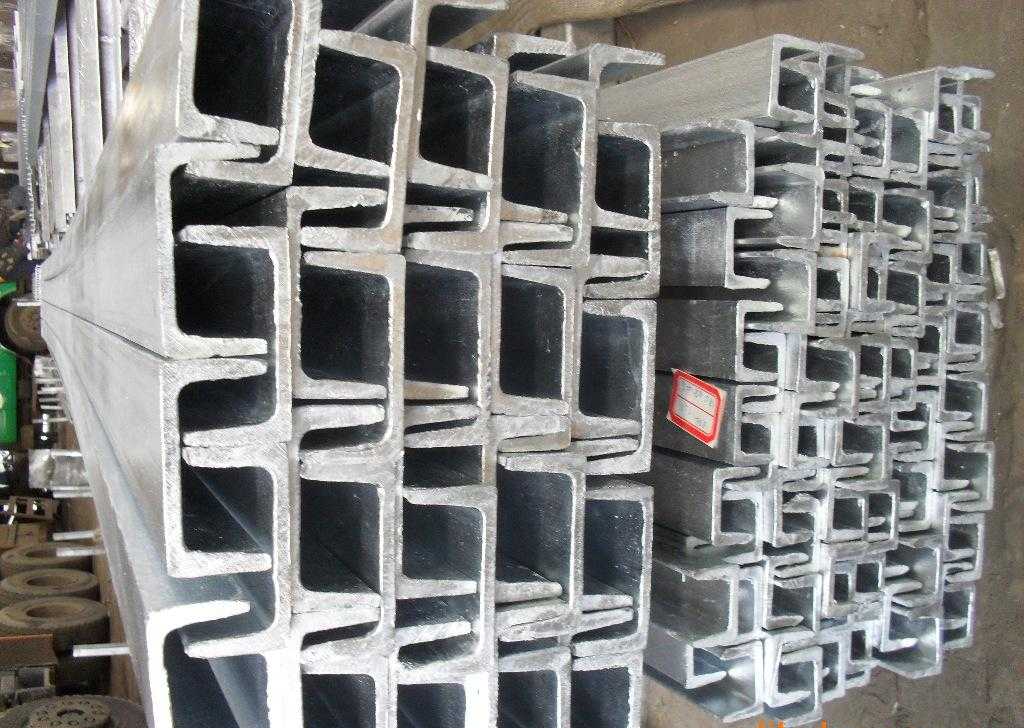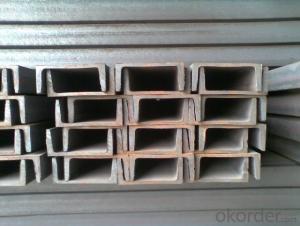Galvanised Strut C Channel AISI,ASTM,BS,DIN,GB,JIS
- Loading Port:
- Guangzhou
- Payment Terms:
- TT OR LC
- Min Order Qty:
- 1000 PCS
- Supply Capability:
- 20000 PCS/month
OKorder Service Pledge
OKorder Financial Service
You Might Also Like
Galvanised C Channel Steel Details
Standard: | AISI,ASTM,BS,DIN,GB,JIS | Dimensions: | 41*21 41*41 41*61 41*82 |
Grade: | Steel.HDG.FRP.ZP,SS304.SS316 | Perforated Or Not: | Is Perforated |
Shape: | C Channel | Application: | construction |
thickness: | 1.5mm 2.0mm,2.5mm 3mm |
Packaging & Delivery
Packaging Detail: | Standard exortation package or as requirement of client |
Delivery Detail: | 10-20 Days |
Galvanised C Channel Steel Performance:
Convenient in construction and save much time and labor
Light and cheap
Length of the product can be manufactured according to customers' requirement
High mechanical strength
Various kinds of fittings can make up of many combinations also for sale
Attractive in appearance
Galvanised C Channel Steel Pictures


- Q:Can steel channels be used for roof truss systems?
- Yes, steel channels can be used for roof truss systems. Steel channels are commonly used in construction for their strength and durability, making them suitable for supporting roof trusses and distributing the weight of the roof.
- Q:What are the different methods for protecting steel channels from corrosion?
- There are several methods for protecting steel channels from corrosion. One common approach is applying a protective coating, such as paint or powder coating, which creates a barrier between the steel and the environment. Another method is galvanizing, where a layer of zinc is applied to the steel surface through hot-dip or electroplating, providing corrosion resistance. Additionally, using stainless steel channels, which contain a high percentage of chromium, can offer excellent corrosion resistance. Regular maintenance, such as cleaning and removing accumulated debris or moisture, can also help prevent corrosion on steel channels.
- Q:A solar roof concrete foundation steel embedded parts, steel embedded parts are welded on the welding channel, two channel to head to head up, ask whether the welding part of a steel plate welding lining need? Or what other requirements? What norms do these requirements come from? Thank you
- Steel mosaic, can be spliced according to the below methods: adopt web side welding stiffened plate (installed in the groove of the inner channel of the stiffened plate, flange plate groove) by sealing welding, welding seam groove cutting and slag inclusions shall be clean; check inspection after welding. The web stiffener is greater than or equal to the thickness of the web. The dimension of the reinforcing plate is: the length of the steel plate is equal to the height of the section steel, and the width is equal to the height of the section steel, minus 70mm.
- Q:What does channel 160 type 140*40 steel pipe mean?
- Channel steel is a long strip steel with a cross section, and a section shaped steel with a cross section.
- Q:What are the factors to consider when determining the appropriate length of a steel channel?
- When it comes to determining the ideal length for a steel channel, there are several factors that must be taken into consideration. These factors encompass the purpose of the channel, the structural requirements, and the limitations imposed by manufacturing and transportation processes. To begin with, the intended use of the steel channel plays a pivotal role in determining its length. The purpose for which the channel will be employed, whether it be to support beams, frame structures, or act as a conduit, will dictate the appropriate length. It is imperative to thoroughly assess the specific requirements of the project and ensure that the chosen length of the channel aligns with the overall design plan. Additionally, the structural requirements of the application must be accounted for. Elements such as load-bearing capacity, deflection limits, and the necessity for additional support or reinforcement can influence the suitable length of the steel channel. Engineering calculations and structural analysis should be carried out to ascertain the necessary dimensions and ensure that the channel is capable of withstanding the anticipated forces and stresses. Furthermore, it is important to consider the limitations imposed by manufacturing and transportation processes. Steel channels are typically produced in standard lengths, so it is crucial to select a length that minimizes material waste and cost. The logistics of transportation, such as the size of the delivery vehicle or the availability of suitable transportation methods, may also impact the maximum length that can be feasibly used for a project. Other factors that should be taken into account include the installation process, fabrication requirements, and any potential future modifications. It is vital to evaluate these aspects in order to ensure that the chosen length of the steel channel is practical, cost-effective, and aligned with the overall objectives of the project. In conclusion, determining the appropriate length of a steel channel necessitates considering the intended use, structural requirements, manufacturing and transportation limitations, installation process, fabrication requirements, and potential future modifications. By carefully assessing these factors, one can select a length that fulfills the needs of the project while guaranteeing structural integrity and efficiency.
- Q:Can steel channels be used for handrail supports?
- Yes, steel channels can be used for handrail supports. Steel channels provide strength and durability, making them suitable for supporting handrails and ensuring safety.
- Q:Can steel channels be used for modular construction?
- Yes, steel channels can be used for modular construction. Steel channels provide strength, durability, and versatility, making them suitable for various applications in modular construction. They can be used as structural components, support beams, or framing elements, allowing for efficient and flexible construction of modular buildings.
- Q:Can steel channels be used in the aerospace manufacturing industry?
- The aerospace manufacturing industry can utilize steel channels. These channels are versatile and sturdy components that find application in various areas within aerospace manufacturing. They can be employed in constructing aircraft frames, wings, and other structural parts. Steel channels possess an exceptional strength-to-weight ratio, making them suitable for aerospace applications where reducing weight is essential. They can withstand high temperatures, extreme loads, and harsh operating conditions, making them an ideal choice for the aerospace industry. Moreover, steel channels are easily fabricated, welded, and assembled, enabling efficient and cost-effective manufacturing processes. Their dimensional stability and durability ensure the longevity and reliability of aerospace components. However, it is crucial to note that material selection in the aerospace industry is a critical procedure, and specific requirements and regulations must be met. Therefore, engineers and designers must thoroughly assess the application, performance, and compliance of steel channels before incorporating them into aerospace manufacturing processes.
- Q:Are steel channels suitable for marine applications?
- Yes, steel channels are suitable for marine applications. Steel channels are made from a strong and durable material that is resistant to corrosion, making them ideal for marine environments where there is constant exposure to saltwater. They can withstand the harsh conditions of the ocean, including high levels of moisture, waves, and wind. Additionally, steel channels offer excellent structural integrity and can provide support and stability for various marine structures such as piers, docks, and offshore platforms. They are also commonly used in shipbuilding and the construction of marine vessels. Overall, steel channels are a reliable and practical choice for marine applications due to their strength, corrosion resistance, and ability to withstand the demanding conditions of the marine environment.
- Q:Can steel channels be used for column stiffeners?
- Indeed, column stiffeners can utilize steel channels. Within construction and engineering domains, steel channels are frequently employed to augment the robustness and steadiness of structural elements. When functioning as column stiffeners, steel channels are commonly mounted vertically onto the column, heightening its ability to bear loads and withstand sideways pressures. Such stiffeners play a pivotal role in averting column buckling and distortion, thereby guaranteeing its structural integrity. The preference for steel channels as column stiffeners arises from their exceptional strength-to-weight ratio, durability, and effortless installation process.
1. Manufacturer Overview |
|
|---|---|
| Location | |
| Year Established | |
| Annual Output Value | |
| Main Markets | |
| Company Certifications | |
2. Manufacturer Certificates |
|
|---|---|
| a) Certification Name | |
| Range | |
| Reference | |
| Validity Period | |
3. Manufacturer Capability |
|
|---|---|
| a)Trade Capacity | |
| Nearest Port | |
| Export Percentage | |
| No.of Employees in Trade Department | |
| Language Spoken: | |
| b)Factory Information | |
| Factory Size: | |
| No. of Production Lines | |
| Contract Manufacturing | |
| Product Price Range | |
Send your message to us
Galvanised Strut C Channel AISI,ASTM,BS,DIN,GB,JIS
- Loading Port:
- Guangzhou
- Payment Terms:
- TT OR LC
- Min Order Qty:
- 1000 PCS
- Supply Capability:
- 20000 PCS/month
OKorder Service Pledge
OKorder Financial Service
Similar products
New products
Hot products
Related keywords




























